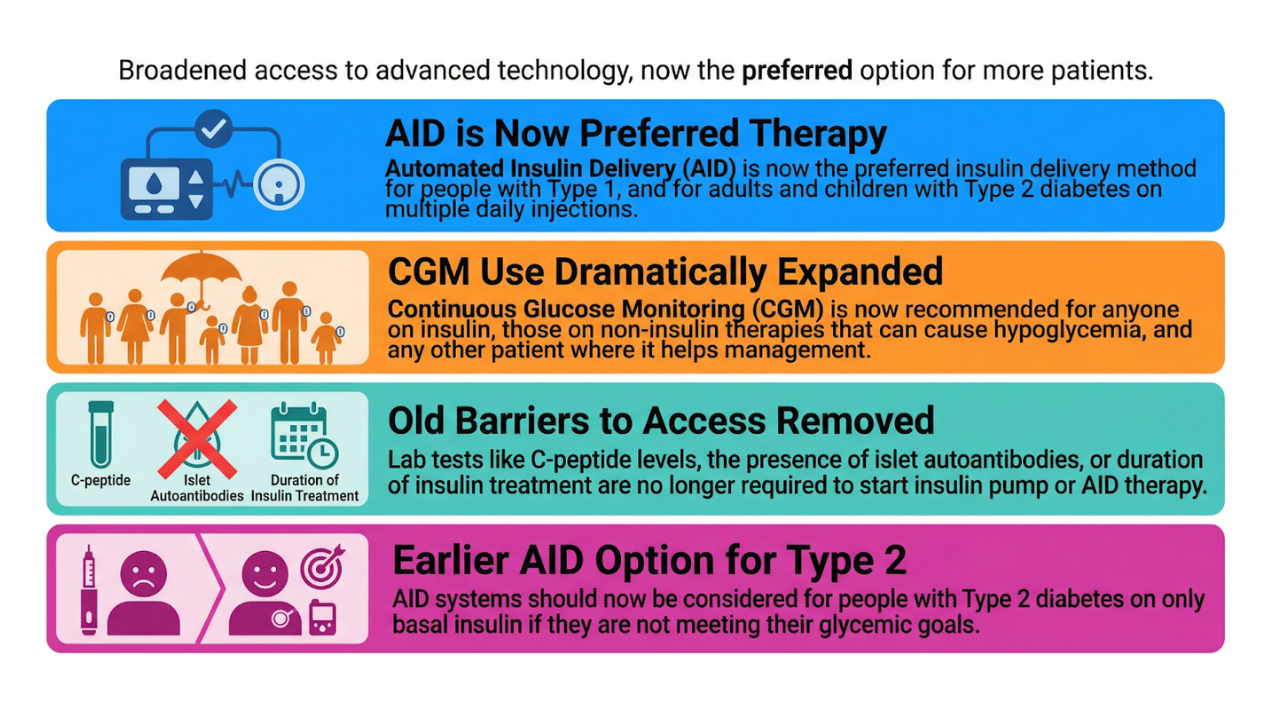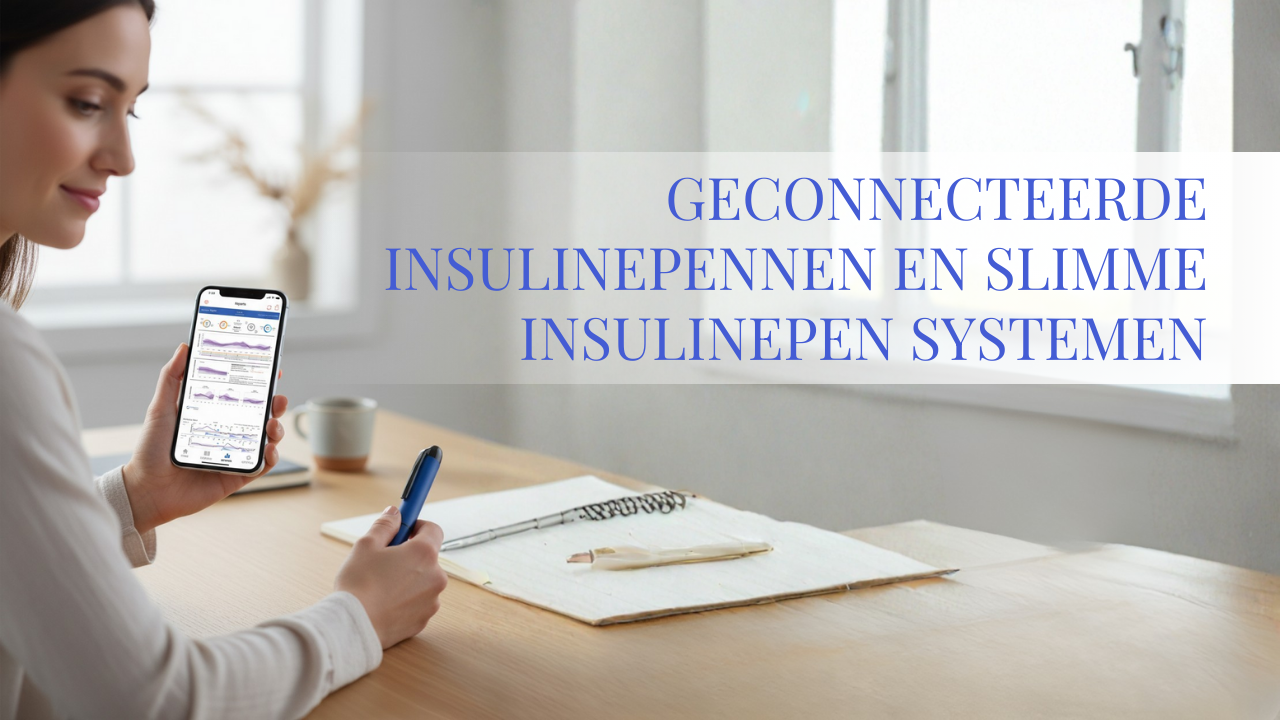Exercising Safely with Automated Insulin Delivery Systems
Jan 01, 2025
This podcast is created by NotebookLM based on this blogpost and the EASD/ISPAD guidelines on the use of AID systems during physical activity and exercise in type 1 diabetes.
In 2024, the European Association for the Study of Diabetes (EASD) and the International Society for Pediatric and Adolescent Diabetes (ISPAD) collaborated to create comprehensive practice guidelines on using different automated insulin delivery (AID) systems during exercise. This work, published on December 10th, 2024, provides invaluable insights into managing blood glucose levels during physical activity for people with diabetes.
This blog synthesizes these guidelines to help people living with diabetes and their healthcare professionals to understand and implement the recommendations effectively.
Get Access To Updated Diabetes Technology Courses
Let’s dive into the key takeaways.
1. Why AID systems matter during exercise
2. General principles for exercise with AID systems
3. Recommendations for specific AID systems
- #1 Minimed 780G
- #2.1 Tandem t:slim X2 with Control-IQ technology
- #2.2 Tandem Mobi with Control-IQ technology
- #3 Omnipod 5
- #4 mylife Loop
- #5 Diabeloop
- #6 iLet Bionic Pancreas
- #7 AndroidAPS
- #8 DIY Loop
- #9 iAPS / Trio
- #10 TouchCare Nano System
4. Overview AID specific recommendations
5. Watch and listen to the Experts
6. Conclusion
1. Why AID Systems Matter During Exercise

AID systems—combining continuous glucose monitoring (CGM) and insulin pumps—are the preferred choice for insulin delivery in people type 1 diabetes and insuline-deficient diabetes,
and they should also be considered for people with type 2 diabetes on multiple daily injections (cfr ADA Guidelines).
Yet, maintaining optimal glucose control during physical activity remains a challenge.
Exercise impacts glucose levels differently:
-
Aerobic activities (e.g., running) typically lower glucose, increasing the risk of hypoglycemia.
-
Anaerobic activities (e.g., weightlifting) can cause glucose spikes.
-
Mixed activities (e.g., team sports) may have variable effects.
These guidelines offer tailored recommendations for planned and unplanned physical activity to optimize glucose management.
2. General Principles for Exercise with AID Systems

1. Adjust Glucose Targets Based on Activity Types
Recognize that different activities affect glucose levels uniquely:
- For aerobic exercise, anticipate glucose drops and consider higher glucose targets.
- For anaerobic exercise, expect potential glucose spikes and maintain usual targets.
2. Distinguish Planned vs. Unplanned Activity
For planned physical activity (PA):
- Set a higher glucose target 1–2 hours before exercise if a stable or decreasing glucose trend is expected. Maintain regular or lower targets if glucose is likely to increase.
- If exercising within 2 hours of a carb-heavy meal, reduce the meal bolus by 25–33% if glucose is expected to decrease during exercise. Always set a higher glucose target before reducing bolus insulin doses.
For unplanned PA:
- Immediately set a higher glucose target if a stable or decreasing glucose trend is expected. Consume 10–20 grams of fast-acting carbohydrates if glucose is below 126 mg/dl (7.0 mmol/l).
- Maintain regular or lower targets if a glucose increase is expected.
3. Monitor Glucose Trends with CGM
Leverage CGM data to manage glucose in real time:
- Small amounts of fast-acting carbohydrates (3–20 grams) can stabilize glucose if levels drop below 126 mg/dl (7.0 mmol/l). Avoid overcorrecting to minimize post-exercise hyperglycemia.
- Use trend arrows to guide carbohydrate intake during exercise: 3-6 grams if ➡️, 6-9 grams if ↘️, 9-12 grams if ⬇️ and 12-20 grams if ⬇️⬇️ or ⬇️⬇️⬇️.
- Recheck glucose levels 20–30 minutes after carbohydrate consumption and repeat treatment if needed.
4. Consider Insulin on Board (IOB)
Timing matters when balancing exercise and IOB:
- Exercise preferably when IOB is low, such as before meals or in a fasted state.
- After meals, low-intensity exercise can help bring elevated glucose back to target.
- Avoid exercise if glucose exceeds 270 mg/dl (15.0 mmol/l) with blood ketones >1.5 mmol/L.
By integrating these strategies with your AID system, you can better navigate the challenges of exercise while maintaining safe and effective glucose management.
3. Recommendations for specific AID systems
#1 MiniMed 780G

The SmartGuard algorithm allows you to prevent hypoglycemia during physicial exercise via
- a dedicated activity mode, called Temp Target that raises the glucose target to 150 mg/dl (8.3 mmol/l) and stops autocorrection boluses
- it's also possible to change your glucose target to 100, 110 or 120 mg/dl (5.6, 6.1 or 6.7 mmol/l) based on your needs
- and you can enter less carbs during meals. It's not possible to override the amount of insulin suggested by the Bolus Wizard.
Recommendations for use of the MiniMed 780G system to manage glucose outcomes during physical exercise.
- Insulin delivery suspension with or without disconnection for prolonged periods (up to 120 min) may be required under some circumstances (e.g. swimming, diving, contact sports), although it is generally not recommended for most activities, as several of these strategies cannot be implemented and/or require modification.
- PA, physical exercise. SG, sensor glucose. CHO, carbohydrates.
- Glucose values: 100 mg/dl = 5.6 mmol/l, 110 mg/dl = 6.1 mmol/l, 120 mg/dl = 6.7 mmol/l, 126 mg/dl = 7.0 mmol/l

Click here for a printer friendly version of this diagram in mg/dl or mmol/l.
#2.1 Tandem t:slim X2 with Control-IQ technology

Control-IQ technology allows you to prevent hypoglycemia during physical activity via
- a dedicated activity mode, called Exercise Acticity that raises the glucose target range to 140-160 mg/dl (7.8-8.9 mmol/l).
- It's also possible to create and switch to an extra Personal Profile based on your needs,
- and you can enter less carbs during meals or lower the amount of insulin suggested by the bolus calculator.
Recommendations for use of the Tandem t:slim X2 pump with Control-IQ technology to manage glucose outcomes during physical exercise.
- Consider adding a minimal manual bolus dose (e.g. 0.05 U) close to the onset of exercise to block the system from administering auto-correction doses for the next 60 min.
- Insulin delivery suspension with or without disconnection for prolonged periods (up to 120 min) may be required under some circumstances (e.g. swimming, diving, contact sports), although it is generally not recommended for most activities, as several of these strategies cannot be implemented and/or require modification.
- PA, physical activity. SG, sensor glucose. ISF, insulin sensitivity factor. CHO, carbohydrates.
- Glucose value: 126 mg/dl = 7.0 mmol/l

Click here for a printer friendly version of this diagram in mg/dl or mmol/l.
#2.2 Tandem Mobi with Control-IQ technology

Tandem Mobi was not mentioned in the published guidelines, although we assume the recommendations are the same as for the t:slim X2 insulin pump as they both work with Control-IQ technology
#3 Omnipod 5

The SmartAdjust algorithm allows you to prevent hypoglycemia during physical activity via
- a dedicated activity mode, called Activity Feature that raises the glucose target range to 150 mg/dl (8.3 mmol/l).
- It's also possible to change your glucose target to 110-150 mg/dl (6.1-8.3 mmol/l) based on your needs in time blocks of 1 hour
- and you can enter less carbs during meals or lower the amount of insulin suggested by the SmartBolusCalculator.
Note: some people recommended to disable the "Reverse Correction" option if you are going to enter less carbs for your meal, as otherwise the insulin reduction might be too strong, leading to postprandial hyperglycemia.
Recommendations for use of the Omnipod 5 system to manage glucose outcomes during physical activity.
- PA, physical activity. SG, sensor glucose. CHO, carbohydrates.
- Glucose values: 110 mg/dl = 6.1 mmol/l, 120 mg/dl = 6.7 mmol/l, 126 mg/dl = 7.0 mmol/l

Click here for a printer friendly version of this diagram in mg/dl or mmol/l.
#4 mylife Loop

The CamAPS FX algorithm allows you to prevent hypoglycemia during physical activity via
- a dedicated activity mode, called Ease-off that raises the glucose target range with 45 mg/dl (2.5 mmol/l), increases the insulin sensitivity with 50% and stops insulin delivery if glucose is < 126 mg/dl (7.0 mmol/l).
- It's also possible to change your glucose target to 80-200 mg/dl (4.4-11.0 mmol/l) based on your needs in time blocks of 30 minutes
- and you can enter less carbs during meals or lower the amount of insulin suggested by the bolus calculator (the latter option is preferred to let the system know you actually ate more).
- It's also possible to enter carbs as hypoglycemia treatment so the algorithm will not give you insulin for it.
Recommendations for use of the mylife CamAPS FX system to manage glucose outcomes during physical activity.
- Insulin delivery suspension with or without disconnection for prolonged periods (up to 120 min) may be required under some circumstances (e.g. swimming, diving, contact sports), although it is generally not recommended for most activities.
- PA, physical activity. SG, sensor glucose. CHO, carbohydrates.
- Glucose values: 80 mg/dl = 4.4 mmol/l, 100 mg/dl = 5.6 mmol/l, 120 mg/dl = 6.7 mmol/l, 126 mg/dl = 7.0 mmol/l, 150 mg/dl = 8.3 mmol/l

Click here for a printer friendly version of this diagram in mg/dl or mmol/l.
#5 Diabeloop

The DBLG1 algorithm allows you to prevent hypoglycemia during physicial activity via
- a dedicated activity mode, called Physical Activity that raises the target value and hypo- and hyperglycemia thresholds with 70 mg/dl (3.9 mmol/l).
- Zen mode on the other hand will raise the target value with 10-40 mg/dl (0.6-2.2 mmol/l).
- It's also possible to change your glucose target to 100-130 mg/dl (5.6-7.2 mmol/l) based on your needs
- and you can enter less carbs during meals or lower the amount of insulin suggested by the bolus calculator.
- It's also possible to enter carbs as hypoglycemia treatment so the algorithm will not give you insulin for it.
Recommendations for use of the DBLG1 system to manage glucose outcomes during physical activity.
- Insulin delivery suspension with or without disconnection for prolonged periods (up to 120 min) may be required under some circumstances (e.g. swimming, diving, contact sports), although it is generally not recommended for most activities, as several of these strategies cannot be implemented and/or require modification.
- PA, physical activity. SG, sensor glucose. CHO, carbohydrates.
- Glucose values: 100 mg/dl = 5.6 mmol/l, 110 mg/dl = 6.1 mmol/l, 120 mg/dl = 6.7 mmol/l, 126 mg/dl = 7.0 mmol/l

Click here for a printer friendly version of this diagram in mg/dl or mmol/l.
#6 iLet Bionic Pancreas

The iLet Dosing Decision Software allows you to prevent hypoglycemia during physical activity via
- pausing/suspending the insulin delivery.
- It's also possible to change your glucose target to 110, 120 or 130 mg/dl (6.1, 3.7 or 7.2 mmol/l - also known as "Lower", "Usual" or "Higher" target) based on your needs
- and you can enter a smaller meal amount during meals ("Less" witll give you 50% less insulin then a "Usual for me" meal)
Recommendations for use of the iLet Bionic Pancreas system to manage glucose outcomes during physical activity.
- Consider insulin delivery suspension with or without disconnecting the iLet system 30 min prior to activity to help mitigate hypoglycaemia risk.
- If ingesting undeclared CHO and disconnecting the iLet before activity, ensure that the device is already suspended and disconnected prior to CHO ingestion.
- The prandial bolus insulin dose can be reduced only by ‘underestimating’ CHO (i.e. entering a smaller meal size).
- PA, physical activity. SG, sensor glucose. CHO, carbohydrates.
- Glucose values: 110 mg/dl = 6.1 mmol/l, 120 mg/dl = 6.7 mmol/l, 126 mg/dl = 7.0 mmol/l, 130 mg/dl = 7.2 mmol/l, 150 mg/dl = 8.3 mmol/l

Click here for a printer friendly version of this diagram in mg/dl or mmol/l.
#7 AndroidAPS

The OpenAPS algorithm allows you to prevent hypoglycemia during physical activity via
- a dedicated target value, called Activity that raises the glucose target to 140 mg/dl (7.8 mmol/l) for 90 minutes, although this can be adjusted according to your needs.
- It's also possible to create and switch to a dedicated glucose Profile based on your needs. The glucose target can be set between 80-200 mg/dl (4.4-11.0 mmol/l)
- and you can enter less carbs during meals or lower the amount of insulin suggested by the bolus calculator.
- It's also possible to enter carbs as hypoglycemia treatment so the algorithm will not give you insulin for it.
The published guidelines did not mention AndroidAPS.
However, based on their recommendations for other AID systems, recommendations on how to use AndroidAPS during physical activity might look like this:

Click here for a printer friendly version of this diagram in mg/dl or mmol/l.
#8 DIY Loop

The Loop algorithm allows you to prevent hypoglycemia during physical activity via
- a dedicated override with a specific Correction Range and/or % of insulin delivery, that you can set according to your needs.
- The Correction Range can be set between 87-180 mg/dl (4.8-10.0 mmol/l)
- and you can enter less carbs during meals or lower the amount of insulin suggested by the bolus calculator.
The published guidelines did not mention DIY Loop.
However, based on their recommendations for other AID systems, recommendations on how to use DIY Loop during physical activity might look like this:

Click here for a printer friendly version of this diagram in mg/dl or mmol/l.
#9 iAPS / Trio

Note: This image is based on the earlier iAPS version 2.3.3. We acknowledge that the current versions, iAPS 5.8.0 and Trio 0.2.2, have notable differences.
The OpenAPS algorithm allows you to prevent hypoglycemia during physical activity via
- a dedicated target glucose, that can be preset according to your needs. The target glucose can be set between 72-180 mg/dl (4.0-10.0 mmol/l).
- Most people opt for a dedicated Profile Override that allows you to specify the target glucose, the % of insulin delivery, and the type of SMBs (supermicroboluses) that should be delivered according to your needs.
- You can also enter less carbs during meals or lower the amount of insulin suggested by the bolus calculator.
The published guidelines did not mention iAPS or Trio.
However, based on their recommendations for other AID systems, recommendations on how to use iAPS or Trio during physical activity might look like this:

Click here for a printer friendly version of this diagram in mg/dl or mmol/l.
#10 TouchCare Nano System

The APGO algorithm allows you to prevent hypoglycemia during physical activity via
- a dedicated activity mode, called Activity that raises the glucose target to 150 mg/dl (8.3 mmol/l).
- It's also possible to change your glucose target to 100, 110 or 120 mg/dl (5.6, 6.1 or 6.7 mmol/l) based on your needs
- and you can enter less carbs during meals. It's not possible to override the amount of insulin suggested by the bolus calculator.
The published guidelines did not mention the TouchCare nano System.
However, based on their recommendations for other AID systems, recommendations on how to use TouchCare Nano System during physical activity might look like this:

Click here for a printer friendly version of this diagram in mg/dl or mmol/l.
4. Overview AID specific recommendations
This overview shows a summary of the published recommendations in a different format, based on a presentation of dr Moser @Diatec2024:

Click here for a printer friendly version of this diagram in mg/dl or mmol/l.
5. Watch and Listen to the Experts

An engaging way to dive into these guidelines is by watching the interview with Drs. Othmar Moser and Dessi Zaharieva.
As the first 2 authors, they provide valuable insights from the joint EASD/ISPAD position paper on optimizing the use of AID systems during exercise for individuals with type 1 diabetes.
Visit the EASD e-learning platform to watch the interview and take away their key recommendations.
We'd also like to extend our gratitude to all the authors for their significant contributions to this important field: Othmar Moser, Dessi P. Zaharieva, Peter Adolfsson, Tadej Battelino, Richard M. Bracken, Bruce A. Buckingham, Thomas Danne, Elizabeth A. Davis, Klemen Dovč, Gregory P. Forlenza, Pieter Gillard, Sabine E. Hofer, Roman Hovorka, Peter G. Jacobs, Julia K. Mader, Chantal Mathieu, Kirsten Nørgaard, Nick S. Oliver, David N. O’Neal, John Pemberton, Rémi Rabasa-Lhoret, Jennifer L. Sherr, Harald Sourij, Martin Tauschmann, Jane E. Yardley, and Michael C. Riddell.
6. Conclusion
Managing exercise with diabetes and AID systems demands both preparation and a clear understanding.
These guidelines serve as a valuable foundation for tailoring strategies to enhance safety and optimize glucose control, empowering individuals with type 1 diabetes to lead active lifestyles supported by advanced diabetes technology.
However, it’s essential to recognize that guidelines are not rigid rules but flexible frameworks. They must be adapted to each person's unique circumstances, as the personal element is crucial. A one-size-fits-all approach is simply not sufficient.
For a deeper dive into AID systems and their applications, we invite you to enroll in our Diabetes Technology Expert Program.
Discover comprehensive courses and practical tools to expand your expertise and elevate your practice.
Visit www.diabetotech.com/all-courses and start your FREE courses now!
Kind regards,





